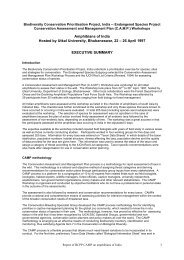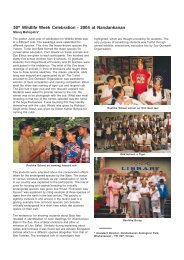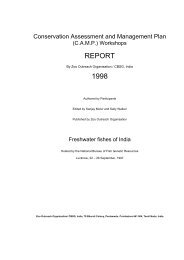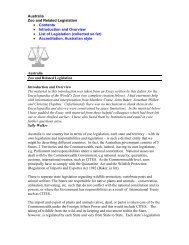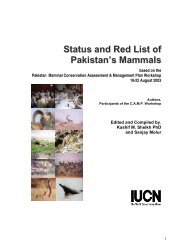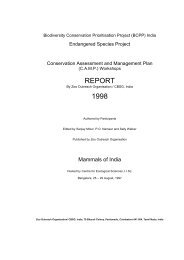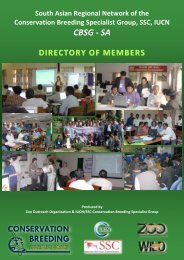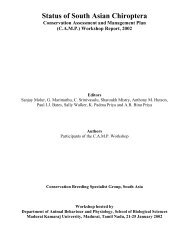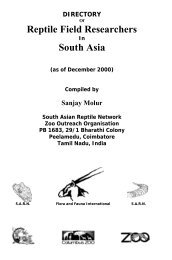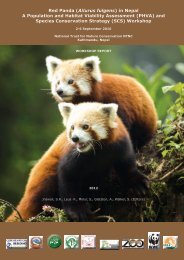Bugs R all March 2011 FINAL daniel - Zoo Outreach Organisation
Bugs R all March 2011 FINAL daniel - Zoo Outreach Organisation
Bugs R all March 2011 FINAL daniel - Zoo Outreach Organisation
- No tags were found...
Create successful ePaper yourself
Turn your PDF publications into a flip-book with our unique Google optimized e-Paper software.
On a documentaEon of Haddon’s Carpet anemone (S-chodactyla haddoni)(Saville-‐Kent 1893) (Anthozoa: AcEniaria: SEchodactylidae) and its unique symbioEc fauna from Gulf of KutchUnmesh Katwate 1* , Prakash Sanjeevi 2Wildlife Research Rescue and Conserva,on Club (WRRACC), WWF, Panvel-‐410206, India*Author for correspondence: Email: theunmesh@gmail.com1Plot no. 11, House no. 878, Adarsha nagar, Palaspe, Panvel, Raigad, Panvel 410 2062105, Aram nagar Part I, Kakori camp, near CIFE University, Seven bungalows, Andheri (west) Mumbai 400458Email: 1 theunmesh@gmail.com; 2 prakashteene11@gmail.comSea anemones are primi,ve forms belonging to the phy-lum Cnidaria. The characteris,c feature of this group is the presence of nematocysts for protec,on and prey capture. Sea anemones are known to prey upon many fish species by means of venomous tentacles (Gudger 1941; Mariscal 1966a), but they are also known for their symbio,c asso-cia,on with different fishes (Mariscal 1972; Day 1878), different shrimps (Bruce 1976) and crabs (Biosearch v 1.2, 2009).One such anemone is S3chodactyla haddoni (Fig. 2) which was first described by Saville-‐Kent in 1893. Reef associate Haddon’s anemone occurs in sh<strong>all</strong>ow tropical and sub-tropical seas from the red sea, throughout the Indian Ocean to New Caledonia, Japan to Australia and in Singa-pore (Dunn 1981, Fau,n and Allen 1992, Fau,n 2008 and 2009).The size of S. haddoni ranges from 300-‐500 mm in diame-ter and rarely more. Broad flat to sh<strong>all</strong>ow undula,ng oral disc is densely covered with hundreds of slightly tapering tentacles. Oral disc around mouth bare, yellowish to or-ange colored tentacles. Column commonly whi,sh or brownish with rose or purple colored verrucae; tapering to pedal disc and are much narrower than the oral disc (Dunn 1981, Fau,n and Allen 1992).In Indian coral reef regions S. haddoni were recorded from Andaman and Nicobar Islands (Madhu et al. 2007), Gulf of Mannar (Mahadevan and Nair 1965) as well as from Gulf of Kutch (Trivedi 1975 and Parulekar 1989).In previous literature it was reported as Stoichac3s gigan-teum (Trivedi 1975 and Parulekar 1989) which was the synonym of S. haddoni as reported from the Andaman and Nicobar Islands (Madhu et al. 2007). In Indian regions S. haddoni is reported in associa,on with clown fish Amphi-prion sp. (Day 1878, Mahadevan and Nair 1965, Trivedi 1974) and with anemone shrimp Periclimenes sp. (Schen-kel 1902) (Arthropoda: Malacostraca: Decapoda: Palae-monoidea) (Trivedi 1975).In this present study, aIempts were made to ascertain the availability of S. haddoni and its symbio,c fauna, habitat, distribu,on and abundance from Gulf of Kutch. The Gulf of Kutch forms almost the northern limits of coral forma-‐,on in the Indian Ocean. It consists of 42 islands at its southern side, 34 of which have corals on one or the other shores. The remainder of the Gulf of Kutch consists of silt and clay with patches of fine cor<strong>all</strong>ine sand and the redis-tribu,on of sediments from its interac,ons with ,dal cur-rents results in irregular topography of the Gulf (Hashimi et al 1978). Extensive studies were conducted in the coral reef areas of Gulf of Kutch (Fig. 1) such as Mithapur (22 0 24’N 68 0 58’E), Narara Island (22 0 27’N 69 0 40’E), Karumb-har Island (22 o 27’N 69 o 38’E), Goose reef (22 o 29’N 69 o 49’E) and Munde reef (22 o 30’N 69 o 50’E). Karumbhar is the largest of 42 islands in the Gulf of Kutch, having an area of around 60km 2 . The reef at Karumbhar Island is pla‚orm reef, which contains cor<strong>all</strong>ine sand at its bed. The sea bed of Narara reef and Mithapur area was rocky with cor<strong>all</strong>ine sand and with luxuriant growth of coral colonies in scaIered patches. The sea bed of Munde and Goose reefs were covered with patch type coral forma-‐,ons. The boIom substratum of Munde reef was covered with enormous dead coral pieces and sandy clay (Sen Gupta et al. 2003). Studied reef flat area for Mithapur was around 3km long having 200-‐250m wide lower inter,dal region. About 4km long Narara reef area was accessed which showing largest lower inter,dal region of about 400-‐650m wide. Karumbhar Island and Munde reef pos-sesses 3km and 1km long reef flat area with 100-‐150m and 200-‐300m wide lower inter,dal region. Goose reef stands unique among the study area as it submerged completely during high ,de, about 1km area was studied during low ,de. Preliminary surveys were carried out in the above study site from April – May 2010 by snorkeling and visual census was also carried out in the selected sites by laying 100x100m quadrates during low ,de to find out the popula,on density. Three quadrates (QI, QII, and QIII) were laid randomly at the interval of 100m in each study site in the lower inter,dal region and the observa,ons were recorded (Table 1). Haddon’s anemones are found to be restricted to lower inter,dal region and in sub,dal up to 7-‐8m accessed depth. Habitat preference by anemones was also observed in inter,dal pools having sandy substratum. Under water documenta,ons were <strong>Bugs</strong> R A! No. 17 <strong>March</strong> <strong>2011</strong> 31



